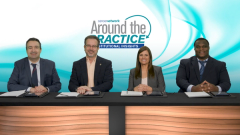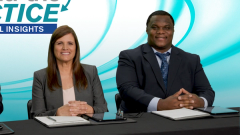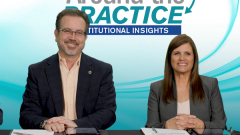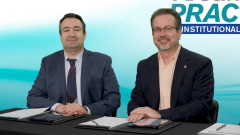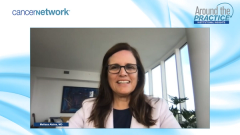
Patient Profile 2: Transplant-Ineligible Newly Diagnosed Multiple Myeloma
Expert perspectives on a patient profile of transplant-ineligible multiple myeloma, with considerations for treatment selection and defining transplant ineligibility.
Episodes in this series

Transcript:
Melissa Alsina, MD: I think we can go ahead and discuss the case, and then try to put all these things we have discussed into a clinical context. Do you want to present the case, Rachid?
Rachid Baz, MD: Sure, this is a 74-year-old lady who sees her PCP [primary care physician] for a routine physical in 2016. The laboratory assessment revealed an elevated total protein, prompting an…which revealed an IgG kappa M-spike of 2.94 g/dL, and she has hypogammaglobulinemia as well. Her total IgG is 4363 [mg/dL], and the free kappa light chains are 398 [mg/L], with a free light chain ratio of 55. Her creatinine is 0.98 [mg/dL], she has no hypercalcemia, her hemoglobin is 11.1 [g/dL], which has been slowly declining. Beta-2 is 2.9 [mg/L], and her albumin is normal. Her medical history includes diabetes, hypertension, and hypothyroidism, and she takes metformin, glipizide, metoprolol, lisinopril, levothyroxine, and gabapentin. Her bone marrow biopsy revealed 75% involvement, with kappa-restricted plasma cells, with a FISH [fluorescence in situ hybridization] showing a translocation 11;14. A skeletal survey shows an absence of lytic bone disease. So she’s diagnosed with Revised-ISS [International Staging System] stage I, standard risk multiple myeloma.
The case says she’s deemed transplant ineligible. I will spend a minute here to say that actually there is no such thing, but we use the term transplant ineligible. I feel that transplant discussion is a risk-benefit discussion, and perhaps there’s always a possibility to do it, maybe with higher risks. But I don’t know if there is such a thing as ineligibility, it’s all in the eye of the beholder and the transplanter. Obviously, there may be a patient with overt heart failure who may not be a candidate, but I think for a patient like this, you wonder maybe, why is she transplant ineligible? Potentially she could be a borderline candidate, but presumably, maybe her functional state is not as good as we think it is.
How would we treat this patient? I’m going to tell you how I would treat this patient. I think this is a patient for whom a daratumumab, lenalidomide, dexamethasone [DRd]-type induction and therapy makes a lot of sense. I don’t see a reason why she couldn’t receive that therapy safely. I would add that a mini geriatric assessment could be helpful in terms of dosing. Around 75 years of age is when I usually decrease the dexamethasone dose to 20 mg, and there may be a role for a lenalidomide dose reduction depending on the geriatrics assessment. But other than that, I think it’s a patient who would be very well suited for a DRd-type regimen.
Melissa Alsina, MD: What can you add, Ken?
Ken Shain, MD: Looking at the case, and not knowing the actual frailty or performance status, kind of as a rule, she looked very fit for 74 years old, or 74 years young, pardon me. This is a person where I’d say, this is still a quad [quadruplet regimen] patient, so I would still give all 4 drugs. It could be a weekly dosing subq [subcutaneous], we’d dose it based on her frailty. But I think she fits that category where I’d still consider her someone who would be transplant eligible by age and other comorbidities, again, not knowing all the details. I think 4 drugs would be fine for this person, get them the best response they can, and talk to them about the options for transplant. Even if she was 76, and she was transplant eligible by a number, I still think if she was fit enough, 4 drugs would be an OK therapeutic option in this setting. But again, if she wasn’t a 4-drug candidate, DRd would be my choice, based on the risk, etc, in this patient population.
Melissa Alsina, MD: All right.
Brandon Blue, MD: I’ll just say that not all 74-year-olds are the same, right? We’ve seen 74-year-olds who can maybe run circles around some of us on this platform. But then we’ve seen some 74-year-olds who we think we would probably do more harm than good by giving them an autologous stem cell transplant. I think some of the main information I would pull from this is I would not let age by itself be my determining factor to say whether someone should or should not get an autologous transplant. I’d ask, how good of a 74-year-old, what is the performance status like? I think as Dr Baz was saying, trying to use some type of assessment, whether it be cognitive, or some type of physical. Whether or not 2 months ago this patient was running 5 miles a day. Really trying to get an understanding of where this patient is because it’s very likely that regardless of the treatment you may give the patient, the patient may likely get to whatever that functional status was prediagnosis, or at least close to it. So you might be depriving them of something when you are looking at a patient just [based on] the condition, and you’re unfortunately missing out on a potential opportunity to give someone optimal therapy.
Melissa Alsina, MD: Yes, so this person wasn’t high risk, right?
Brandon Blue, MD: No.
Melissa Alsina, MD: What I’m going to say shows there are multiple things you can do with these patients, depending on who the patient is, and so on. But let’s say he’s a 74-year-old patient, exactly as you said, they have diabetes, high blood pressure, and that’s it, no high-risk myeloma. I would agree with Rachid, I would treat with DRd because as we discussed, the DRd data are excellent. This person has a very good chance of getting into remission, even MRD [minimal residual disease] negativity. And I agree with Brandon, age by itself doesn’t determine whether a patient should be a transplant candidate. I think it’s obviously the other serious comorbidities, like heart disease, lung disease, and not even kidney disease. But I think in the elderly population, or in the older population, response dictates a lot about what we do with these patients.
In our treatment algorithms, after the MAIA study results came out, and we started using DRd in many of our patients, we are trying to give those patients a more response-adapted approach. If we have a 74-year-old patient who could potentially be a transplant candidate, we treat them until best response, and if that patient achieves a CR [complete response] or even MRD negativity, we don’t push it with the transplant. We hold off and see how the patient does. However, on the other hand, if you treat a patient, maybe even with what Kenny is saying, RVd [lenalidomide, bortezomib, dexamethasone]-dara [daratumumab], 74 years old, and the patient doesn’t achieve remission or VGPR [very good partial response], then I would say I will take this patient to transplant to try to deepen their response. Because we know that’s going to influence their progression-free survival and their overall survival. So I think the transplant question in this patient population is a bit more dynamic and more open because it depends on many factors, the comorbidity of the patient, but also how good of a response you can get with your induction therapy.
Ken Shain, MD: Yes, I think that’s spot on. That’s where this group of individuals on that quasi-peri 75, 76 years old, plus or minus, where you are like, what do you do? This is where we can feel comfortable using MRD data to help us make decisions about whether we use transplant. We talk about it all the time, but the therapy is high-dose melphalan, which is not fun. It’s also fraught with some long-term adverse effects. I think this is that patient population where the data aren’t as strong in the world because they aren’t transplanted a lot, at least in studies. We use that MRD negativity, or CR, or really close to MRD negativity, early as a good decision point. I agree with you 100%, that’s where you say, this is where I might take some of the data before we know the answer, and use that for these individuals, where we are able to save them potential toxicities that may or may not be as helpful as you want.
Melissa Alsina, MD: Right. The last point I want to make, and I would like for you to comment on this too, is what about a sequential approach to therapy? When we start a patient on DRd, for example, the median time to response is 1 month. So I give the treatment for 1 month, 1 cycle, and if that M-spike is not moving, then I add my proteasome inhibitor [PI]. Or I give the treatment for 2 cycles, and I haven’t achieved a partial response yet, then I add a PI, and we keep doing it like that, right? What do you think about that? Maybe Rachid, you can even comment on your study.
Rachid Baz, MD: Yes, I think this is a very good point; a lot of trials haven’t looked at this. We’re looking at it as part of an investigator-initiated study for patients who are elderly, and a lot of them are frail. The median age of patients enrolled so far was 79, and half were frail. What we’ve done is given daratumumab and dexamethasone, and after 2 cycles, if they’ve achieved a partial response, they can continue. If they have not, then we’ve added lenalidomide and bortezomib.
The choice was informed by a platform that Ken developed called EMMA, Ex Vivo Myeloma Mathematical Advisor, a kind of ex vivo drug screening that will tell you this person’s myeloma responds better to lenalidomide vs a proteasome inhibitor, and then we can try to tailor the therapy. We’re doing this on trial; I think this is something that could also be adapted for the very frail elderly. The results we’re seeing so far have been presented at ASH [American Society of Hematology annual meeting] and look really good. The overall response to the approach is 95%. So we’re kind of getting to where MAIA is, but with a maximum rate of grade 3 and 4 adverse events of less than 5% for each toxicity. That is really good, we’re trying to not get that toxicity for patients, but get the same type of benefit, and do it in a sequential way.
Ken Shain, MD: Fantastic points.
Melissa Alsina, MD: Very interesting.
Transcript edited for clarity.
Newsletter
Stay up to date on recent advances in the multidisciplinary approach to cancer.


